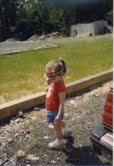Once, on my birthday, I saw Billy Collins read some of his work.
He talked about the kind of poetry he admires, and the kind he aspired to write. He described a poem as a house, a mansion - inside, there can be any number of rooms, decorated any way you wish, with any number of things happening.
But mansion or humble cottage, any house must have a door. A poem, like a house, must have a way inside.
So too must an education.
In my graduate program, we talked a lot about multiple entry points into curriculum. I do think it's important to have a diverse number of ways to connect with whatever subject matter is at hand, whether it's art, science, writing, whatever. But here's the thing. No matter what you're studying, the way inside is to feel that it's worth walking through the door. That whatever's on the other side is something you want to see.
How do you make that happen?
Open up all the windows, let in the light.
And more detailed information will be coming soon, but for now, know this: letting in the light is exactly what I plan to do.
Tuesday, May 25, 2010
Saturday, May 8, 2010
Make Peace.
"I know how to protest war, but I don't know how to make peace."
These were words heard by the leader of a church in Manhattan when visiting a Quaker meeting. They became the subject of a prayer ribbon project that caught my eye one day, and I'm so glad I stopped to read how the project came about. I thought about these words again a few weeks ago as a committee that I've been serving on put the finishing touches on our curriculum.
The curriculum we've designed is an attempt to help children make peace. Or, as I've seen somewhere or other (on a bumper sticker, probably), to "wage" peace. Because peace is exactly like war, in the sense that it doesn't come from nowhere. Peace, like war, arises from a series of small decisions and a variety of influences. Peace has a history.

We talked a lot about peace, justice, and mutual respect; we talked about how such abstract values can be made concrete for children. Turns out there's a lot we can do. We can provide examples, by setting up games and role-playing, we can present problems for the children to solve together.
These were words heard by the leader of a church in Manhattan when visiting a Quaker meeting. They became the subject of a prayer ribbon project that caught my eye one day, and I'm so glad I stopped to read how the project came about. I thought about these words again a few weeks ago as a committee that I've been serving on put the finishing touches on our curriculum.
The curriculum we've designed is an attempt to help children make peace. Or, as I've seen somewhere or other (on a bumper sticker, probably), to "wage" peace. Because peace is exactly like war, in the sense that it doesn't come from nowhere. Peace, like war, arises from a series of small decisions and a variety of influences. Peace has a history.

(photo from http://www.flickr.com/photos/33981855@N04/3164684831/)
We talked a lot about peace, justice, and mutual respect; we talked about how such abstract values can be made concrete for children. Turns out there's a lot we can do. We can provide examples, by setting up games and role-playing, we can present problems for the children to solve together.
More than that, we can also be examples. We can work to be at peace with ourselves and with others. To illustrate what this doesn't look like, I think about a child in my class: her mother understands child development, and in particular knows what kind of child her daughter is, and instead of being at peace with that, has been steadily working to make her feel bad about herself. (Example: the girl had an accident, as recently-turned-4-year-olds sometimes do, and mom berated her in front of her teachers and other parents, then came back the next week and berated us teachers as well for good measure.) Most recently, she gave me a series of forms to fill out, attempting to get her daughter diagnosed with a disorder she doesn't have.
This girl, will she be able to make peace? Will she struggle with her thoughts, second-guessing her own experience and in turn second-guessing others throughout her days, because her mother cannot respect who she is and be just?
Peace has a history, and that history is written with every choice we make.
Subscribe to:
Comments (Atom)
